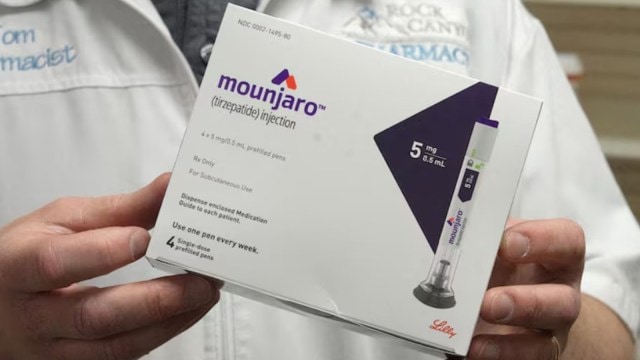Weight loss drug Mounjaro in India: Who needs it, how long should you have it and will weight come back?
Dr Anoop Misra, chairman, Fortis C-DOC for Diabetes and Allied Sciences, lays down the drug protocol
 Tirzepatide is primarily intended for people with Type 2 diabetes who cannot control their blood sugar despite following a proper diet and taking other medications. (Photo: Reuters)
Tirzepatide is primarily intended for people with Type 2 diabetes who cannot control their blood sugar despite following a proper diet and taking other medications. (Photo: Reuters)Now that one of the most advanced weight loss drugs, Mounjaro, is to be sold in India by US pharma major Eli Lilly, there’s curiosity about its long-term effects and whether the lost weight comes back. Dr Anoop Misra, chairman, Fortis C-DOC for Diabetes and Allied Sciences, has already come across a few patients who have used Mounjaro, having obtained them from outside India. Every patient experienced significant weight loss but there’s a catch that all of us must know about.
“While the weight loss results were impressive across the group, the cost and side effects remain important barriers for long-term use. Two of them discontinued after a few months due to the high cost. One of these patients also experienced severe vomitting and couldn’t tolerate the drug, leading to early discontinuation,” says Dr Misra.
While Mounjaro has been shown to reduce weight loss by about 20 per cent in tests, similar to bariatric surgery, studies have shown that those that discontinue after six months regain 14 per cent of their body weight. While the residual effect of Mounjaro may be the longest among this class of weight loss drugs, continuing it for a longer time period has shown that 90 per cent of people could keep the weight off. The ideal way to go forward is to factor in sustainability, which, according to Dr Misra, means making diet and exercise key pillars of the weight loss journey once the patient goes off the weight cliff. Excerpts:
What is the difference between Mounjaro and Ozempic?
Mounjaro contains an active substance called tirzepatide which mimics the action of certain gut hormones to improve secretion of the blood-sugar regulating insulin, inhibits secretion of glucagon that stimulates glucose production in the liver, and also reduces appetite by slowing down digestion. It mimics two hormones, glucagon-like peptide-1 (GLP-1) and the glucose-dependent insulinotropic polypeptide (GIP), to lower blood sugar and promote weight loss. In contrast, semaglutide works on GLP-1 alone.
Studies have shown that tirzepatide leads to greater weight loss and better blood sugar control than semaglutide with some patients losing over 20 per cent of their body weight on higher doses. Both medications are highly effective but tirzepatide’s dual mechanism offers an additional advantage, especially for weight management.
Who really needs it? Though it is approved as a weight loss drug, should it be used only by people with diabetes? What is the obesity threshold?
Tirzepatide is primarily intended for people with Type 2 diabetes who cannot control their blood sugar despite following a proper diet and taking other medications. It is also approved for weight loss in obese individuals (body mass index BMI 30 kg/m2 or higher) or overweight individuals (BMI 27 kg/m2 or higher) who have weight-related health problems like diabetes, high blood pressure, or heart disease. It’s not for cosmetic weight loss or shedding a few kilos casually—it’s a potent, medically supervised treatment requiring careful consideration of its purpose and risks.
What is the protocol for using tirzepatide?
Tirzepatide is a prescription-only injectable medication, primarily approved for managing type 2 diabetes and now also for weight loss. The starting dose is 2.5 milligrams (mg) once a week for 4 weeks to help the body adjust. After that, the dose increases to 5 mg weekly. If more weight loss or better blood sugar control is needed, the dose can be gradually increased to 7.5 mg, 10 mg, 12.5 mg, and a maximum of 15 mg weekly, with each increase happening every 4 weeks. Dose escalation must be done under a doctor’s supervision to avoid side effects such as nausea, vomitting, or more severe issues like pancreatitis (inflammation of the pancreas) and hypoglycemia (low blood sugar). While it may be possible to get the drug without a prescription in India, this is unsafe and not advisable. Regular medical monitoring is crucial to manage side effects and ensure the medication is working properly.
Once you start the medication, how long should you continue it?
Tirzepatide is designed for long-term use, especially for people managing type 2 diabetes or chronic obesity. It’s not meant for short-term weight loss. Patients usually continue the medication as long as they are seeing sustained benefits — improved blood sugar levels, weight loss (Trials emphasize gradual, sustained reduction (e.g., 15-23% body weight over 72 weeks) and reduced cardiovascular risk — without troublesome side effects. If blood sugar remains stable and weight loss plateaus at a healthy level, dose may be tapered or stopped. Still, like other medicines for long-term conditions, stopping tirzepatide could cause weight to come back and blood sugar to get worse, though maybe not as bad as it was at the start.
Who should avoid it entirely?
Tirzepatide should not be used by people with type 1 diabetes, those with severe kidney or liver disease, individuals with a personal or family history of thyroid cancer, pregnant women or those planning to conceive. Anyone with severe gastrointestinal disorders (sluggish intestines, obstruction etc) or a history of pancreatitis should avoid the medication unless specifically advised by a doctor.


- 01
- 02
- 03
- 04
- 05





























